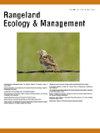Effects of Nocturnal Grazing Behavior and Stock Density on Cattle Dung in Sloped Rotational Grazing
IF 2.4
3区 环境科学与生态学
Q2 ECOLOGY
引用次数: 0
Abstract
In this study, we investigated the effects of nocturnal variation in grazing behavior and stock density on the distribution of cattle dung in a sloped rotational grazing system in Japan. The specific objectives were to determine the influence of watering sites on dung distribution at night and the relationship between stock density and dung distribution. The study was conducted on a 2.56-ha steeply sloped pasture that was divided into four sub-paddocks for rotational grazing. Drone imagery and the YOLO deep learning algorithm were used to automate the mapping of more than 400 cattle dung pats per grazing session, with a mean average precision of 0.75. The YOLO algorithm demonstrated high accuracy in identifying dung that was up to 4 days old. Our analyses revealed that the distance to a watering site influenced fecal distribution during the day, but had a weaker and insignificant effect at night. With low-density grazing, dung pats showed a clumped distribution across the entire pasture, whereas at higher stock density the distribution approached randomness. The formation of four dung hotspots was observed in the pasture, although these spots were not consistently used throughout subsequent grazing periods. The cattle tended to migrate from more elevated foraging areas to more level grazing areas for rest, resulting in a loose connection between foraging and resting sites, and this behavior may have a bearing on the lack of successive utilization of these fecal hotspots. Subsequent research must examine whether these patterns persist across seasonal variations and different grazing lands. Despite this need for validation, our findings can provide insights for guiding sustainable nutrient redistribution and grassland management on sloped terrain through the management of stock density and grazing schedules.
坡地轮牧夜间放牧行为和家畜密度对牛粪的影响
在日本的一个坡地轮牧系统中,我们研究了夜间放牧行为和家畜密度的变化对牛粪分布的影响。具体目的是确定浇水地点对夜间粪便分布的影响以及种群密度与粪便分布的关系。研究在一个2.56 ha的陡坡牧场上进行,该牧场被划分为4个分围场进行轮牧。利用无人机图像和YOLO深度学习算法,每次放牧期间自动绘制400多个牛粪块,平均精度为0.75。YOLO算法在识别长达4天的粪便方面表现出很高的准确性。我们的分析表明,到浇水地点的距离在白天影响粪便分布,但在夜间影响较弱且不显著。放牧密度低时,粪块呈块状分布,而放牧密度高时,粪块呈随机分布。在牧场上观察到四个粪便热点的形成,尽管这些地方在随后的放牧期间并没有一直被使用。牛有从地势较高的觅食区迁移到地势较高的放牧区休息的倾向,导致觅食和休息地点之间的联系较为松散,这种行为可能与这些粪便热点缺乏连续利用有关。随后的研究必须检查这些模式是否在季节变化和不同的放牧地中持续存在。尽管这需要验证,但我们的研究结果可以通过管理种群密度和放牧时间表来指导坡地的可持续养分再分配和草地管理。
本文章由计算机程序翻译,如有差异,请以英文原文为准。
求助全文
约1分钟内获得全文
求助全文
来源期刊

Rangeland Ecology & Management
农林科学-环境科学
CiteScore
4.60
自引率
13.00%
发文量
87
审稿时长
12-24 weeks
期刊介绍:
Rangeland Ecology & Management publishes all topics-including ecology, management, socioeconomic and policy-pertaining to global rangelands. The journal''s mission is to inform academics, ecosystem managers and policy makers of science-based information to promote sound rangeland stewardship. Author submissions are published in five manuscript categories: original research papers, high-profile forum topics, concept syntheses, as well as research and technical notes.
Rangelands represent approximately 50% of the Earth''s land area and provision multiple ecosystem services for large human populations. This expansive and diverse land area functions as coupled human-ecological systems. Knowledge of both social and biophysical system components and their interactions represent the foundation for informed rangeland stewardship. Rangeland Ecology & Management uniquely integrates information from multiple system components to address current and pending challenges confronting global rangelands.
 求助内容:
求助内容: 应助结果提醒方式:
应助结果提醒方式:


